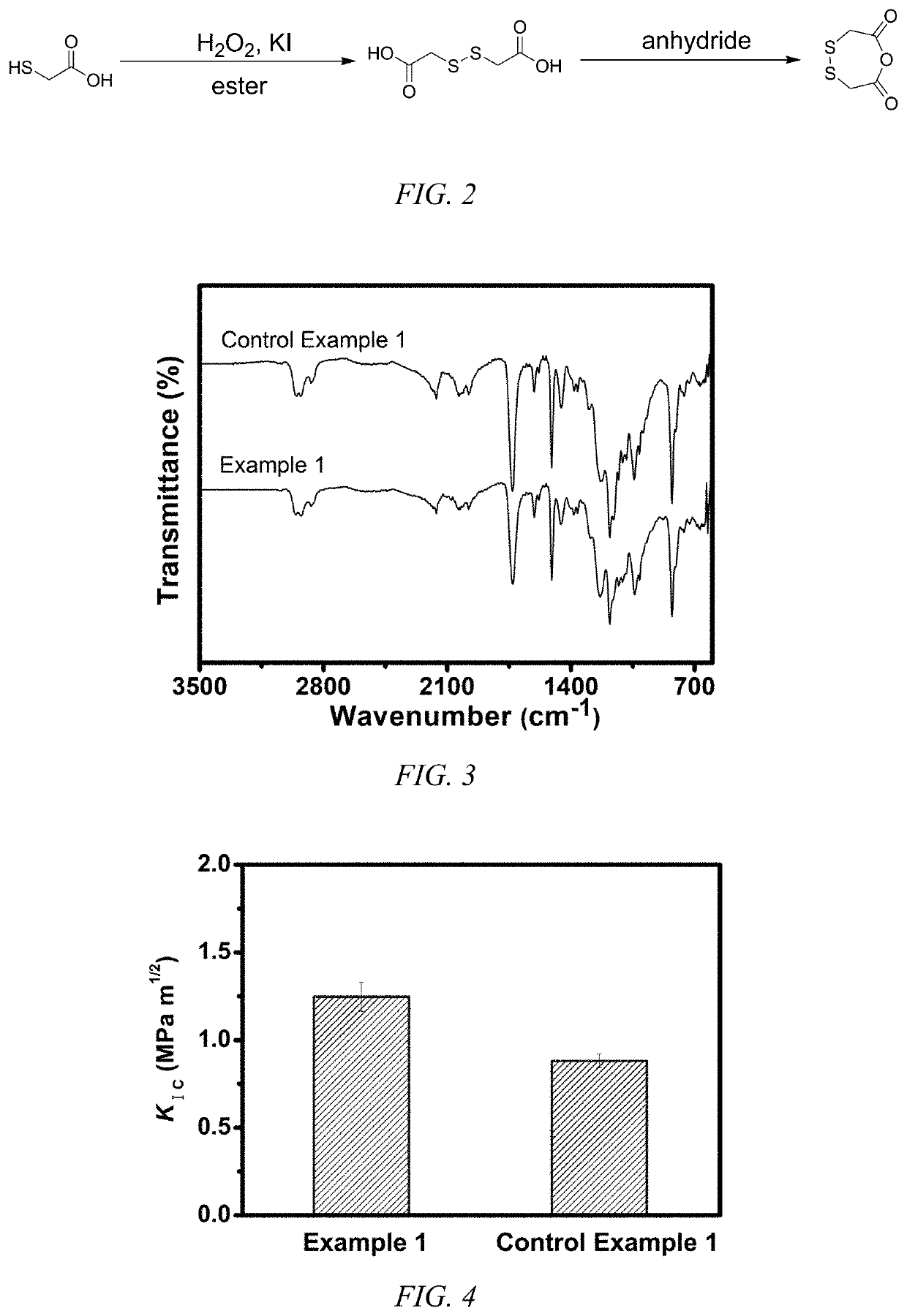Reversible self-repairing epoxy resin and preparation and recovery remoulding method therefor
a self-repairing, epoxy resin technology, applied in the field of thermosetting resins, can solve the problems of high energy consumption, ineffective repair of microcracks or scratches caused by friction and collision, degradation and recycling of thermosetting resins, etc., to achieve excellent self-healing ability, facilitate rapid exchange reaction, and excellent recyclability and remoldability.
- Summary
- Abstract
- Description
- Claims
- Application Information
AI Technical Summary
Benefits of technology
Problems solved by technology
Method used
Image
Examples
example 1
[0038]1) Synthesis of 2,2′-dithiodiacetic acid
[0039]By mass, at 20° C., 120 g 2-mercaptoacetic acid, 500 g ethyl acetate and 0.6 g potassium iodide were mixed homogeneously to obtain a solution A; 80 g 30 wt % H2O2 were added dropwise to solution A and continued to react for 2 h. The obtained solution was washed with 300 mL saturate Na2SO3 aqueous solution and ethyl acetate was removed under reduced pressure to get 2,2′-dithiodiacetic acid. The 1H-NMR spectrum of 2,2′-dithiodiacetic acid is shown in FIG. 1.
2) Synthesis of 1,4,5-oxadithiepane-2,7-dione
[0040]By mass, at 20° C., 100 g 2,2′-dithiodiacetic acid and 150 g trifluoroacetic anhydride were mixed homogeneously and continued to react for 2 h. Excess trifluoroacetic anhydride and generated trifluoroacetic acid were removed under reduced pressure to get 1,4,5-oxadithiepane-2,7-dione. The 1H-NMR spectrum and synthetic route of 1,4,5-oxadithiepane-2,7-dione are shown in FIG. 1 and FIG. 2.
3) Synthesis of Self-Healable Epoxy Resins
[0...
control example 1
Synthesis of Conventional Epoxy Resins
[0042]By mass, at 50° C., 100 g glycidyl ether type epoxy resin (E51, epoxide equivalent weight of 196 g / eq), 86 g methylhexahydrophthalic anhydride and 0.5 g 2-ethyl-4-methylimidazole were mixed homogeneously. After cured by the protocol of 80° C. / 2 h, 100° C. / 2 h, 120° C. / 2 h, 140° C. / 2 h and 160° C. / 4 h, conventional epoxy resin was obtained.
[0043]The fractured surfaces of damaged conventional epoxy resin were brought into contact, held tightly by clamps and maintained at 160° C. for 1 h to fulfill self-healing process.
[0044]The FTIR spectrum, fracture toughness, DMA curves, TGA curve and digital images of self-healing process of conventional epoxy resin are shown in FIG. 3, FIG. 4, FIG. 5, FIG. 6 and FIG. 7.
[0045]FIG. 1 gives 1H-NMIR spectra of 2,2′-dithiodiacetic acid and 1,4,5-oxadithiepane-2,7-dione prepared in Example 1. Compared with 1H-NMIR spectra of 2-mercaptoacetic acid, the proton resonating at 2.78 ppm (c) for mercapto groups is n...
example 2
[0051]1) Synthesis of 2,2′-dithiodiacetic acid
[0052]By mass, at 25° C., 120 g 2-mercaptoacetic acid, 600 g methyl acetate and 0.8 g potassium iodide were mixed homogeneously to obtain a solution A; 85 g 30 wt % H2O2 were added dropwise to solution A and continued to react for 3 h. The obtained solution was washed with 300 mL saturate Na2SO3 aqueous solution and methyl acetate was removed under reduced pressure to get 2,2′-dithiodiacetic acid.
2) Synthesis of 1,4,5-oxadithiepane-2,7-dione
[0053]By mass, at 25° C., 100 g 2,2′-dithiodiacetic acid and 135 g acetic anhydride were mixed homogeneously and continued to react for 3 h. Excess acetic anhydride and generated acetic acid were removed under reduced pressure to get 1,4,5-oxadithiepane-2,7-dione.
3) Synthesis of Self-Healable Epoxy Resins
[0054]By mass, at 60° C., 100 g glycidyl ester type epoxy resin (672, epoxide equivalent weight of 161 g / eq), 52 g of 1,4,5-oxadithiepane-2,7-dione, 32 g methylhexahydrophthalic anhydride and 0.5 g 2-...
PUM
| Property | Measurement | Unit |
|---|---|---|
| Temperature | aaaaa | aaaaa |
| Fraction | aaaaa | aaaaa |
| Fraction | aaaaa | aaaaa |
Abstract
Description
Claims
Application Information
 Login to View More
Login to View More - R&D
- Intellectual Property
- Life Sciences
- Materials
- Tech Scout
- Unparalleled Data Quality
- Higher Quality Content
- 60% Fewer Hallucinations
Browse by: Latest US Patents, China's latest patents, Technical Efficacy Thesaurus, Application Domain, Technology Topic, Popular Technical Reports.
© 2025 PatSnap. All rights reserved.Legal|Privacy policy|Modern Slavery Act Transparency Statement|Sitemap|About US| Contact US: help@patsnap.com



